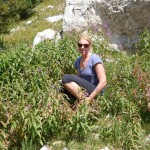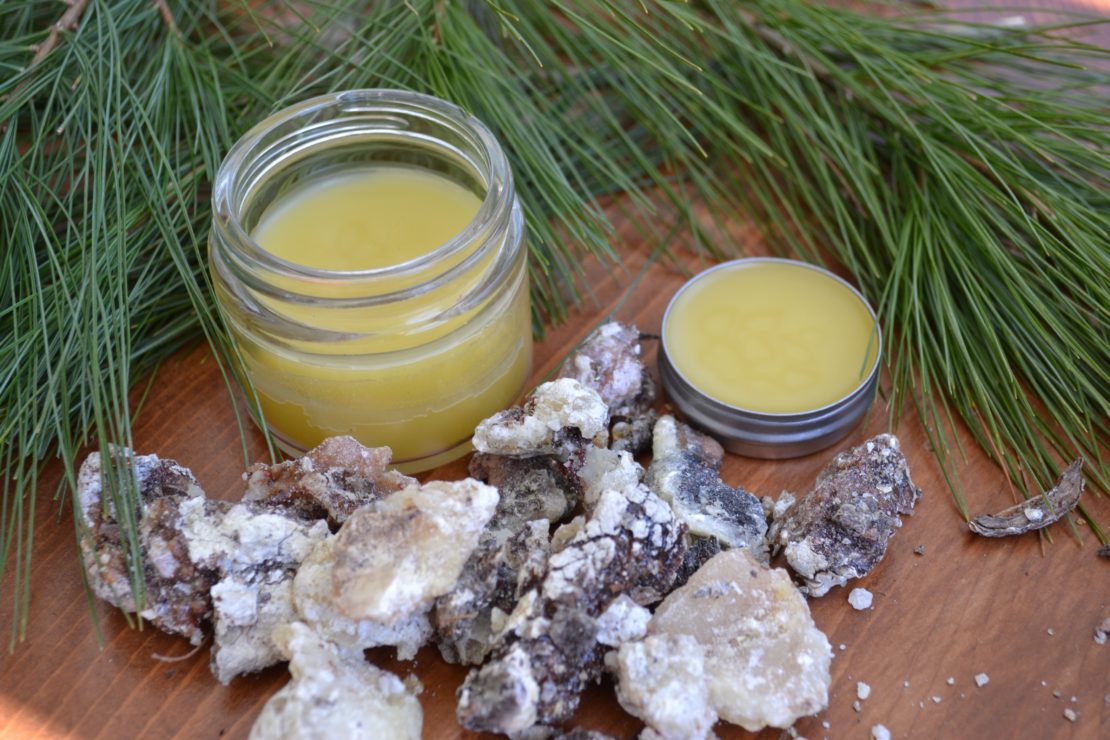
How To Make Pine Resin Salve
One of the thrills of exploring the plants in my local materia medica is stocking my first aid kit with locally sourced herbal preparations. Here in New England we are blessed with more than our fair share of evergreen trees, and in particular an abundant helping of white pine (Pinus strobus). The bark, leaves, and even cones of these trees can be beneficial for edible and herbal uses, and we’ve discussed multiple uses for pine needles before. And that sticky pine resin we’ve all gotten on our skin and clothes at some point? It’s not just an annoyance, it’s beneficial in our first aid kits, too!
Sourcing Resin
The resin from many types of evergreen trees is useful for this project and has been used historically as a topical preparation for wound care. While I’m focusing on white pine in this article, other species of pine (red, pitch, jack, ponderosa, piñon, etc.) as well as spruce and fir can also be called upon and harvested for this use. However, the resin from different evergreens will have different scents, some more “piney” smelling and some (like spruce and fir, in my experience) more “musky” smelling, and ultimately you may find that you prefer the scent of resin from particular types of trees or downright dislike the smell of resin from others!
[Note that pine resin is technically an oleoresin, which is a resin that also contains oil and thus stays relatively soft (Kitsteiner, n.d)—but I refer to it as a resin throughout this article.]
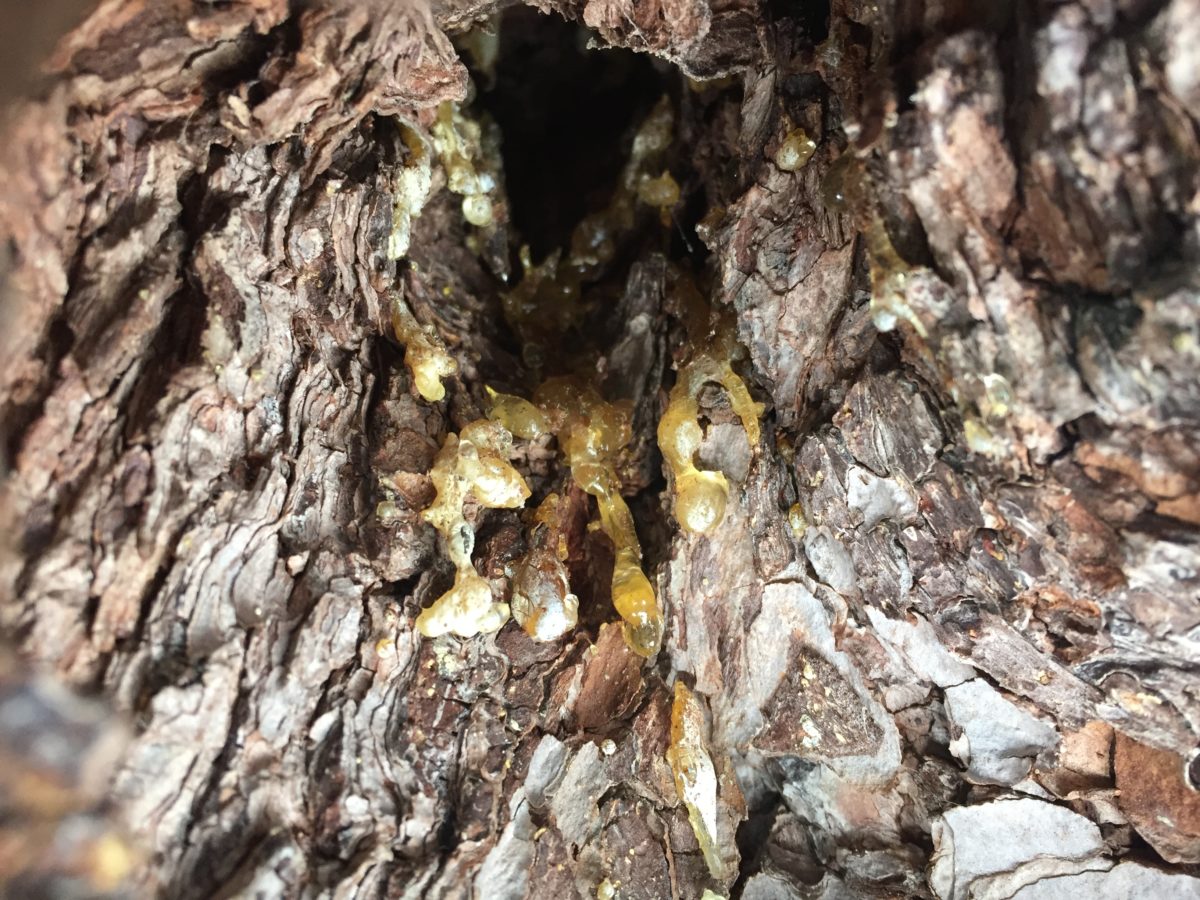
Harvesting Resin
While resin has properties that make it beneficial to us, it’s primary purpose is maintaining the health of the tree. Resin is produced as a protective agent to seal physical wounds and create a barrier to infection by bacteria and fungus or invasion by insects. Resin produced in the tree’s cells are directed through ducts toward an injury and can flush and seal the wound, trap invaders, and act as an antimicrobial to eradicate them (Meyer, n.d.; Trapp & Croteau, 2001).
As such, it’s important to be conscientious when harvesting resin in order not to interfere with the tree’s efforts to maintain its own health. I typically harvest white pine resin that has dripped onto the bark below a wound as this is truly excess resin. Other conifers such as piñon pine produce resin in copious quantities (Rose, 2008), so excess resin is easy to procure from these trees.
Warmer weather months mean the resin will be softer and easier to harvest, although sometimes the hardened chunks can be popped off the tree somewhat easily in colder weather.
I gather resin using a dedicated butter knife and a glass jar. It will stick to everything, so I’ve just set aside equipment for this sole use.
White Pine Resin Benefits
Pine (Pinus spp.) resin has a long history of use by Indigenous people of North America, including for topical applications to disinfect wounds and draw out impurities. White and red pine resin is used by the Anishinaabe in a liniment for cuts and bruises (Genuisz, 2015), while ethnobotanist Enrique Salmón (2020) shares that piñon pine gum is warmed and applied as a poultice to wounds and burns, while the Zuni apply the dried, powdered gum as a wound antiseptic.
The drawing action of resin is of particular interest. Wood (2009) relays herbalist Michael Moore’s (2003) explanation of the drawing action of resins as stimulating topical circulation and increasing inflammation in response to the presence of a foreign body such as a splinter, thus causing pus and fluids to build up and force the splinter out. Kiva Rose describes this similarly, explaining that pine is a counterirritant that stimulates circulation and inflammation, aggravating the local immune response in order to speed up the body’s healing process (Rose, 2008).
It is interesting to note that resins have a drawing effect internally, too. The sticky resin adheres to mucus and draws it out (Wood, 2009) when taken as a tea of the inner bark or when the resin is chewed directly (Michael Moore, 2003).
Pine resin’s antimicrobial properties recommend it as an anti-infective, as its terpene compounds are both antibacterial and antifungal (Vilanova et al., 2014). These actions make it particularly valuable as a topical application to help stave off infection in scrapes and wounds.
The volatile terpenes in pine resin are also helpful for respiratory congestion, and the salve can be rubbed on the chest for this purpose.
Due to its warming and stimulating nature, pine resin salve can also be used as a soothing and warming rub for sore muscles and painful joints.
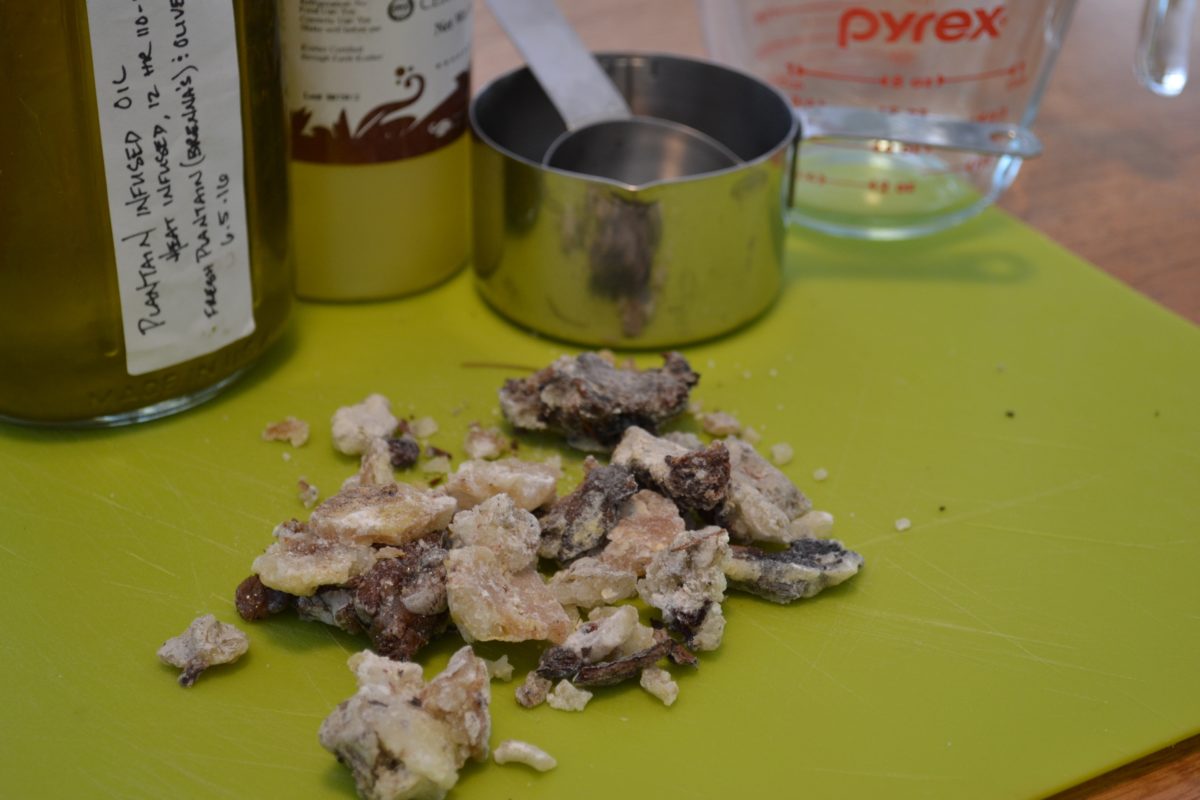
How To Make Pine Resin Salve
Resin is oil soluble and thus is a natural addition to an oil-based salve. This also means that oil can be used to remove the sticky residue from your fingers after handling the resin. Resin is also alcohol soluble, which means you can make a tincture or liniment of resin, and you can use alcohol to remove resin from skin or clothing.
It’s wise to choose a dedicated set of equipment when working with pine resin, and I actually do this for salves and beeswax in general.
My approach to making pine salve is to heat the resin with the oil in a double boiler until the resin has melted and the two combine together. Note that melting large chunks of resin can take a long while—one way around this is to freeze the resin to harden it and then place it in a thick paper bag and break it into smaller pieces with a hammer. The smaller the bits of resin, the quicker they melt!
Because there are typically bits of bark floating around in the mixture, I strain it through a coffee filter before adding the beeswax, although this takes a bit of patience. Alternatively, you can use a fine mesh metal strainer if you don’t mind scrubbing it afterwards.
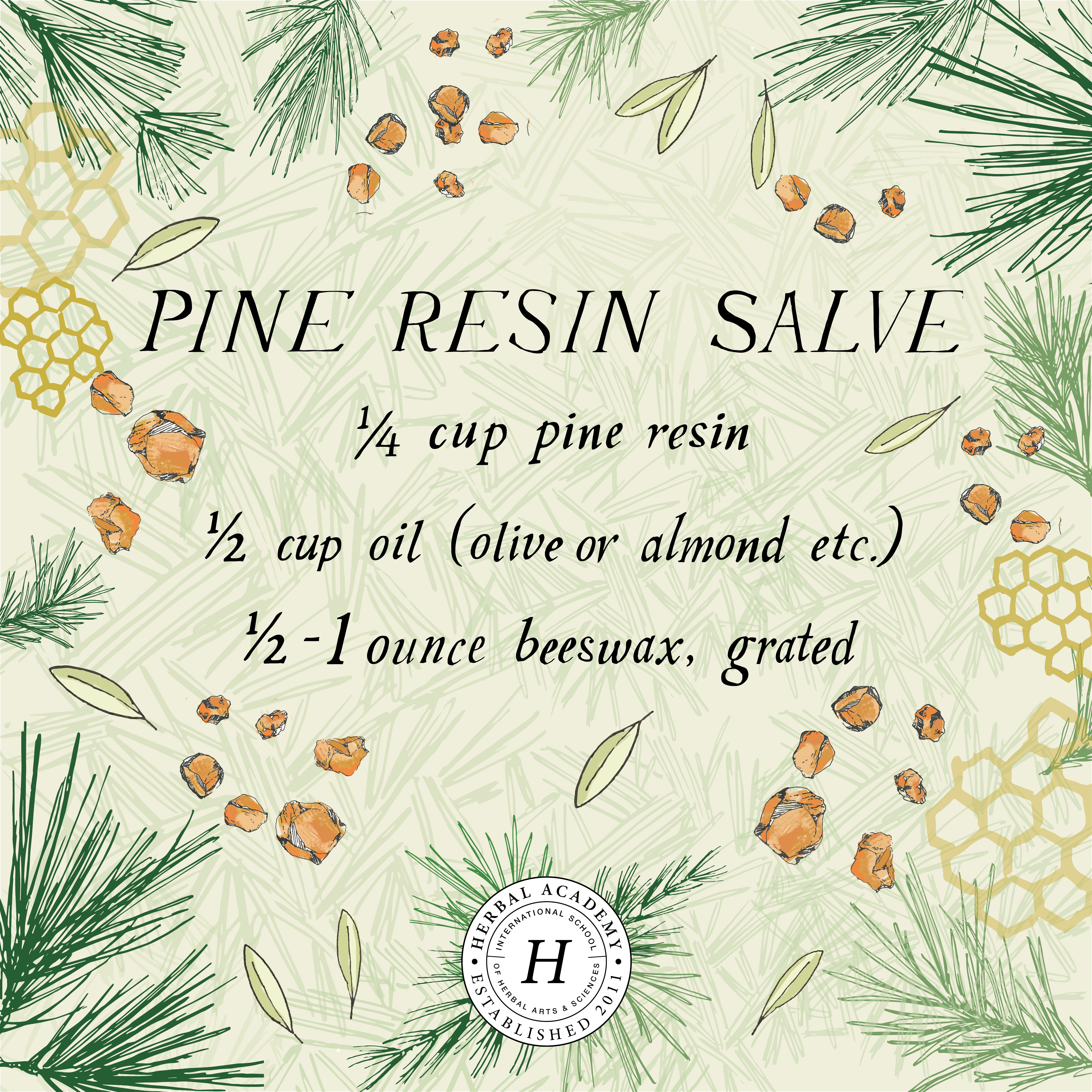
Pine Resin Salve
¼ cup pine resin
½ cup oil (olive, almond, etc.)
½ – 1 ounce beeswax, grated
- Add pine resin to oil in a simmering double boiler. Heat together on low heat until pine resin melts.
- Strain mixture through a coffee filter or strainer.
- Return to double boiler and add grated beeswax. Gently heat until mixture is melted. Pour into tins or jars and store in a cool, dark place.
This is the basic pine resin salve recipe, but note that you could substitute herb-infused oils such as plantain, Calendula, comfrey, or yarrow for the plain oil in order to incorporate more vulnerary and antimicrobial herbs to support the body’s wound healing process. There is certainly room to tweak this formula to your own needs!
Love making herbal salves? You might also be interested in our recipes for Calendula salve, Herbal Burn Salve or Warming Ginger Cayenne Salve for your first aid kit!
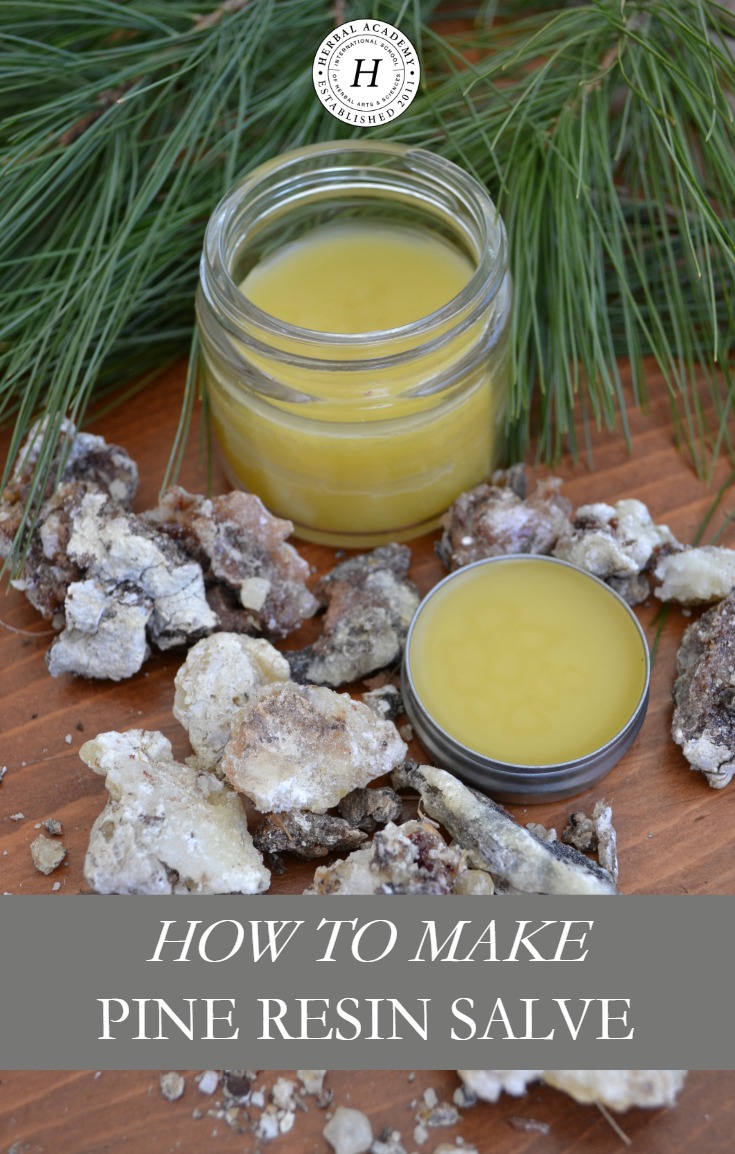
REFERENCES
Geniusz, M.S. (2015). Plants have so much to give us, all we have to do is ask: Anishinaabe botanical teachings. University of Minnesota Press.
Kitsteiner, E. (n.d.). Tapping the pine tree: Resins and their uses. Retrieved from http://tcpermaculture.com/site/2014/08/04/tapping-the-pine-tree-plant-resins-and-their-uses/
Meyer, E. (n.d.). Softwood anatomy. Retrieved from http://www.wood-database.com/wood-articles/softwood-anatomy/
Moore, M. (2003). Medicinal plants of the mountain west. Museum of New Mexico Press.
Rose, K. (2008). Pine pitch salve. Retrieved from http://bearmedicineherbals.com/pine-pitch-salve.html
Salmón, E. (2020). Iwígara: The kinship of plants and people. Timber Press.
Trapp, S. & Croteau, R. (2001). Defensive resin biosynthesis in conifers. Annual Review of Plant Physiology and Plant Molecular Biology, 52, 689-724. DOI: 10.1146/annurev.arplant.52.1.689
Vilanova, C., Marín, M., Baixeras, J., Latorre, A., Porcar, M. (2014). Selecting microbial strains from pine tree resin: Biotechnological applications from a rerpene world. PLoS ONE 9(6): e100740. doi:10.1371/journal.pone.0100740
Wood, M. (2009). The earthwise herbal: A complete guide to new world medicinal plants. North Atlantic Books.

